ASRock Industrial NUC BOX-N97 and GMKtec NucBox G2 Review: Contrasting Compact ADL-N Options
by Ganesh T S on October 6, 2023 9:45 AM EST- Posted in
- Systems
- UCFF
- Mini-PC
- ASRock Industrial
- Alder Lake-N
- micro-PC
- GMKtec
Workstation Performance - SPECworkstation 3.1
SFF PCs traditionally do not lend themselves to workstation duties. In fact, we were never able to get SPECworkstation to complete successfully in any of the Jasper Lake systems. However, things have changed with Gracemont, and we are able to run SPECworkstation 3.1 on ADL-N systems.
The SPECworkstation 3.1 benchmark measures workstation performance based on a number of professional applications. It includes more than 140 tests based on 30 different workloads that exercise the CPU, graphics, I/O and memory hierarchy. These workloads fall into different categories.
- Media and Entertainment (3D animation, rendering)
- Product Development (CAD/CAM/CAE)
- Life Sciences (medical, molecular)
- Financial Services
- Energy (oil and gas)
- General Operations
- GPU Compute
Individual scores are generated for each test and a composite score for each category is calculated based on a reference machine (HP Z240 tower workstation using an Intel E3-1240 v5 CPU, an AMD Radeon Pro WX3100 GPU, 16GB of DDR4-2133, and a SanDisk 512GB SSD). Official benchmark results generated automatically by the benchmark itself are linked in the table below for the systems being compared.
| SPECworkstation 3.1 Official Results (2K) | |
| ASRock NUC BOX-N97 | Run Summary |
| GMKtec NucBox G2 | Run Summary |
| ACEMAGIC T8 Plus | Run Summary |
Details of the tests in each category, as well as an overall comparison of the systems on a per-category basis are presented below.
Media and Entertainment
The Media and Entertainment category comprises of workloads from five distinct applications:
- The Blender workload measures system performance for content creation using the open-source Blender application. Tests include rendering of scenes of varying complexity using the OpenGL and ray-tracing renderers.
- The Handbrake workload uses the open-source Handbrake application to transcode a 4K H.264 file into a H.265 file at 4K and 2K resolutions using the CPU capabilities alone.
- The LuxRender workload benchmarks the LuxCore physically based renderer using LuxMark.
- The Maya workload uses the SPECviewperf 13 maya-05 viewset to replay traces generated using the Autodesk Maya 2017 application for 3D animation.
- The 3ds Max workload uses the SPECviewperf 13 3dsmax-06 viewset to replay traces generated by Autodesk's 3ds Max 2016 using the default Nitrous DX11 driver. The workload represents system usage for 3D modeling tasks.

Product Development
The Product Development category comprises of eight distinct workloads:
- The Rodinia (CFD) workload benchmarks a computational fluid dynamics (CFD) algorithm.
- The WPCcfd workload benchmarks another CFD algorithm involving combustion and turbulence modeling.
- The CalculiX workload uses the Calculix finite-element analysis program to model a jet engine turbine's internal temperature.
- The Catia workload uses the catia-05 viewset from SPECviewperf 13 to replay traces generated by Dassault Systemes' CATIA V6 R2012 3D CAD application.
- The Creo workload uses the creo-02 viewset from SPECviewperf 13 to replay traces generated by PTC's Creo, a 3D CAD application.
- The NX workload uses the snx-03 viewset from SPECviewperf 13 to replay traces generated by the Siemens PLM NX 8.0 CAD/CAM/CAE application.
- The Solidworks workload uses the sw-04 viewset from SPECviewperf 13 to replay traces generated by Dassault Systemes' SolidWorks 2013 SP1 CAD/CAE application.
- The Showcase workload uses the showcase-02 viewset from SPECviewperf 13 to replay traces from Autodesk???s Showcase 2013 3D visualization and presentation application
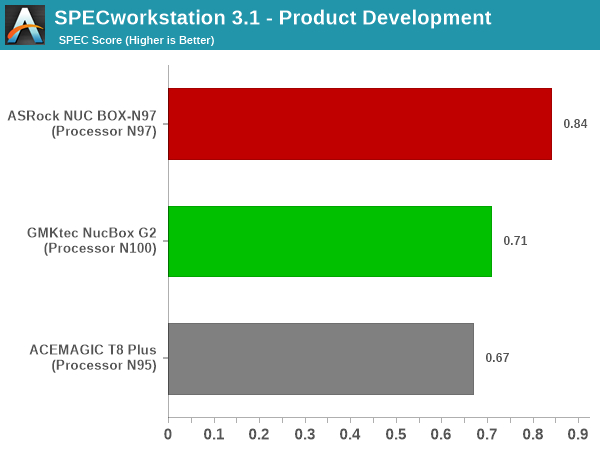
Life Sciences
The Life Sciences category comprises of four distinct test sets:
- The LAMMPS set comprises of five tests simulating different molecular properties using the LAMMPS molecular dynamics simulator.
- The NAMD set comprises of three tests simulating different molecular interactions.
- The Rodinia (Life Sciences) set comprises of four tests - the Heartwall medical imaging algorithm, the Lavamd algorithm for calculation of particle potential and relocation in a 3D space due to mutual forces, the Hotspot algorithm to estimate processor temperature with thermal simulations, and the SRAD anisotropic diffusion algorithm for denoising.
- The Medical workload uses the medical-02 viewset from SPECviewperf 13 to determine system performance for the Tuvok rendering core in the ImageVis3D volume visualization program.
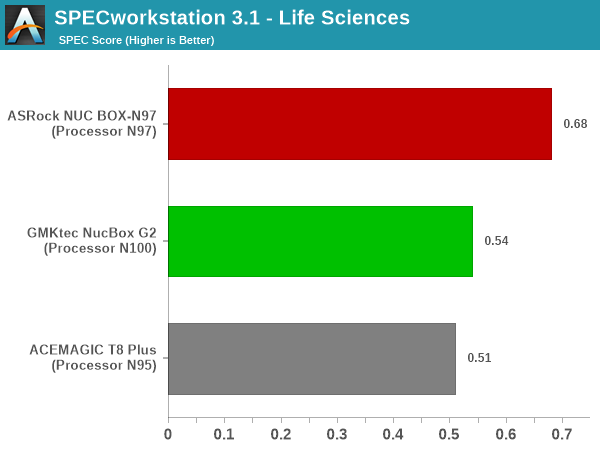
Financial Services
The Financial Services workload set benchmarks the system for three popular algorithms used in the financial services industry - the Monte Carlo probability simulation for risk assessment and forecast modeling, the Black-Scholes pricing model, and the Binomial Options pricing model.
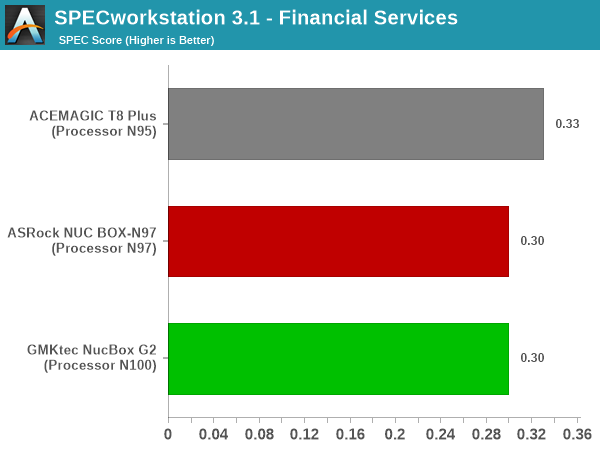
Energy
The Energy category comprises of workloads simulating various algorithms used in the oil and gas industry:
- The FFTW workload computes discrete Fourier transforms of large matrices.
- The Convolution workload computes the convolution of a random 100x100 filter on a 400 megapixel image.
- The SRMP workload processes the Surface-Related Multiples Prediction algorithm used in seismic data processing.
- The Kirchhoff Migration workload processes an algorithm to calculate the back propogation of a seismic wavefield.
- The Poisson workload takes advantage of the OpenMP multi-processing framework to solve the Poisson's equation.
- The Energy workload uses the energy-02 viewset from SPECviewperf 13 to determine system performance for the open-source OPendTec seismic visualization application.
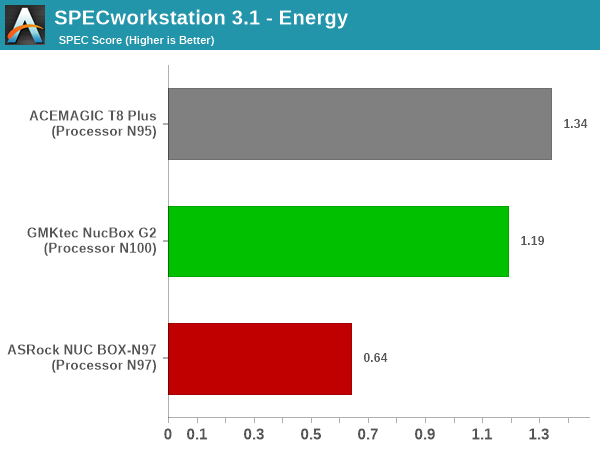
General Operations
In the General Options category, the focus is on workloads from widely used applications in the workstation market:
- The 7zip workload represents compression and decompression operations using the open-source 7zip file archiver program.
- The Python workload benchmarks math operations using the numpy and scipy libraries along with other Python features.
- The Octave workload performs math operations using the Octave programming language used in scientific computing.
- The Storage workload evaluates the performance of the underlying storage device using transaction traces from multiple workstation applications.
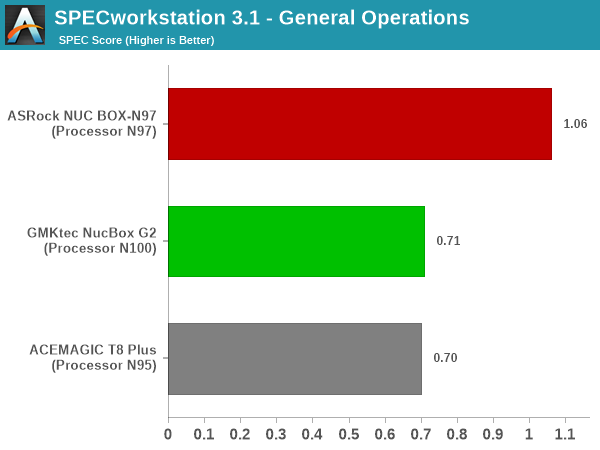
GPU Compute
In the GPU Compute category, the focus is on workloads taking advantage of the GPU compute capabilities using either OpenCL or CUDA, as applicable:
- The LuxRender benchmark is the same as the one seen in the media and entertainment category.
- The Caffe benchmark measures the performance of the Caffe deep-learning framework.
- The Folding@Home benchmark measures the performance of the system for distributed computing workloads focused on tasks such as protein folding and drug design.
We only process the OpenCL variants of the benchmark, as the CUDA version doesn't process correctly with default driver installs.
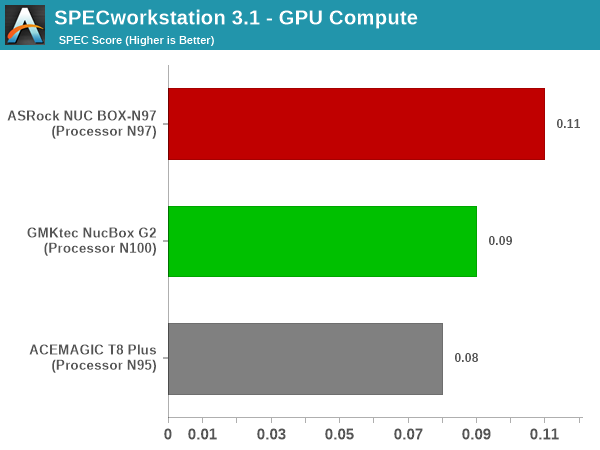
Except for the 'energy' workloads, the NUC BOX-N97 comes out on top by a comfortable margin, with G2 coming in second. The anomaly in the 'energy' workload is likely due to the faster RAM in the G2 compared to the one in the NUC BOX-N97.










20 Comments
View All Comments
meacupla - Friday, October 6, 2023 - link
n100 vs n200, n200 is faster. That I can understandn100 vs n97, n97 is faster. Who came up with this naming scheme?
NextGen_Gamer - Friday, October 6, 2023 - link
Total agree, Intel had the opportunity with a new new series (Intel Processor N) and still messed it up. N50 is 2 cores, 6-Watts. N97, somehow, is 4 cores, at 12-Watts. Then you move "up" to N100, 4 cores, but at 6-Watts. N200 is the same as N100, but gets a small clockspeed bump and finally gets you the full Intel UHD Graphics @ 32 EUs. Then Intel went ahead and named the 8 core ones to Core i3 N300/N305 - why throw the i3 in there??? Why not just keep it as Intel Processor N300? At least the split between N300/N305 makes sense: N305 just gets a higher TDP, and nothing else.mode_13h - Sunday, October 8, 2023 - link
Lots of good points, here. However, the part about N97 can be partially explained in that I believe it's not one of their models meant for things like Chromebooks. Rather, it's more of a specialty/embedded part. If you look at them on ark.intel.com, the N97 lists its product segment as Embedded, while the N100's vertical segment is Mobile.The fact that they're aimed at different segments means their specs don't necessarily have to plot along the same continuum. Though, it'd be nice if they did.
NextGen_Gamer - Monday, October 9, 2023 - link
@ mode_13h - Ahh, you are right, that does explain it, a little at least haha. I am personally waiting for a nice NUC-type box to come around with the N200 in it, and *hopefully* a SO-DIMM for DDR5 and M.2 2280 for the SSD.mode_13h - Monday, October 9, 2023 - link
Beware of how many lanes are active on the SSD, though. PCIe 3.0 x1 is pretty disappointing, though it still beats SATA!I was expecting to see at least x2 - these SoCs don't have a ton of I/O, but they have one more lane than the previous generation. Going back 2 generations, Gemini Lake had only PCIe 2.0 x6! So, you'd really think they could spare at least 2 lanes for NVMe.
NextGen_Gamer - Tuesday, October 10, 2023 - link
I currently have the Intel NUC11ATKPE, with the Pentium Silver N6005 processor. My WD SN850 is running at PCIe 3.0 x2 right now, but I really don't see why these newer Alder Lake-N systems wouldn't want to spare a full PCIe 3.0 x4 for the M.2 slot. I would rather sacrifice other I/O and have your storage subsystem running as fast as it can.deil - Wednesday, October 11, 2023 - link
Well, its buldozer kind of thing.It's NEWER, with ddr5 instead of ddr4 AND $100 cheaper.
If your order them by price, performance matches.
sjkpublic@gmail.com - Friday, October 6, 2023 - link
Are the memory timing right? Seems like the ASROCK is a stronger box. Main diff is 2W of powerat idle? And $30 bucks?
ganeshts - Saturday, October 7, 2023 - link
Yes, memory timing is for LPDDR5-4800 (it is not comparable against DDR4-3200 timings or DDR5 timings).The ASRock box is substantially different from the G2 - check the I/Os and also more importantly it has scope for additional user configuration wrt RAM capacity and SSD capacity. The G2 has soldered RAM.
Btw, the difference in price is not $30, but more than $100. The G2 is ready out of the box for $230 with Win 11 Pro pre-installed. The NUC BOX-N97 needs RAM, SSD / HDD, and OS to be supplied by the user.
mode_13h - Sunday, October 8, 2023 - link
Also, the NUC BOX-N97 is from ASRock Industrial, and therefore presumably built to a higher standard and with better support!I've never heard of GMKtek - do they offer real support for US-based customers? What's the warranty on that unit? How long do you think they'll keep releasing BIOS updates for it?